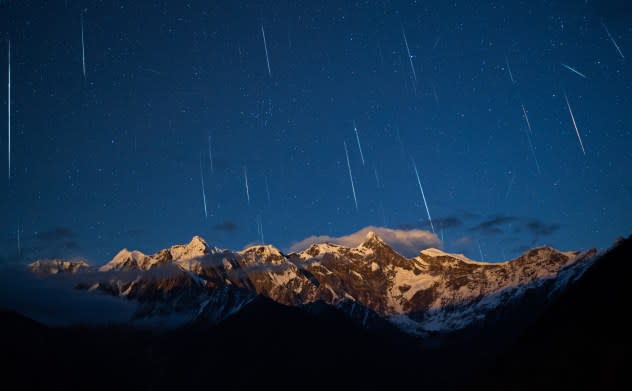Geminid meteor shower is the astronomy event you won't want to miss in December
The 2023 astronomical calendar has been packed with a variety of captivating celestial sights, and the year will conclude with a slate of events that includes a highly-anticipated meteor shower.
December's longer nights present more time for stargazing, including the chance to see the return of the famous constellation Orion. Early morning stargazers have been able to spot Orion for months, but the constellation will return to the evening sky before the end of the year, rising in the east every night around 8 p.m. local time.
From a "cold" moon to shooting stars, here are the astronomy events you won't want to miss this month:
The last major astronomy event of 2023 will put on a dazzling display in the middle of the month, enticing onlookers to bundle up and brave the chilly December weather to catch a glimpse of some shooting stars.
On the night of Wednesday, Dec. 13, into the morning of Thursday, Dec. 14, the Geminid meteor shower will reach its peak. The annual mid-December event is known for producing over 100 shooting stars per hour, including the chance to see a few colorful meteors.
This year should provide excellent viewing conditions, weather permitting, as the Geminids peak on a moonless night, resulting in a darker sky that will make it easier to spot dimmer meteors.
 |
The Geminids over the Himalayas in Tibet (Getty Images) |
The week after the Geminids, the Ursids - the final meteor shower of the year - will peak. However, this natural light show will pale in comparison to the Geminids, only sparking around five to 10 meteors per hour on the night of Dec. 21 into the morning of Dec. 22.
The shortest day and the longest night of the entire year is about to take place for areas north of the equator with the arrival of the solstice.
This year, the solstice takes place at 10:27 p.m. EST on Thursday, Dec. 21, marking the official start of astronomical winter in the Northern Hemisphere and the beginning of astronomical summer in the Southern Hemisphere.
GET THE FREE ACCUWEATHER APP
•Have the app? Unlock AccuWeather Alerts™ with Premium+
While some may feel like the long winter nights drag on, astronomical winter is the shortest season, lasting 88 days, 23 hours and 39 minutes, according to timeanddate.com. This is shorter than autumn, which lasts around 89 days; spring which lasts about 92 days; and summer which lasts for a little longer than 93 days.
The last week of December will feature the final full moon of 2023, one that has several nicknames related to the wintry conditions that expand across North America.
 |
Full moon rises behind an illuminated Christmas tree in Skopje, Macedonia, on Tuesday, Dec. 13, 2016. (AP Photo/Boris Grdanoski) |
On Tuesday, Dec. 26 into Wednesday, Dec. 27, the Cold Moon will illuminate the sky, as long as cloudy conditions do not obscure the celestial sight. According to the Old Farmer's Almanac, the nickname is directly related to the bitterly cold air that often accompanies the long December nights.
Other wintry-themed nicknames for December's full moon include the Snow Moon, the Hoar Frost Moon, the Winter Maker Moon and the Frost Exploding Trees Moon.
Want next-level safety, ad-free? Unlock advanced, hyperlocal severe weather alerts when you subscribe to Premium+ on the AccuWeather app. AccuWeather Alerts™ are prompted by our expert meteorologists who monitor and analyze dangerous weather risks 24/7 to keep you and your family safer.

 Yahoo News
Yahoo News 



